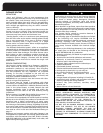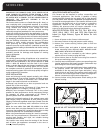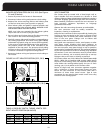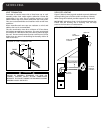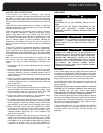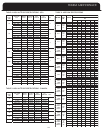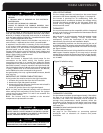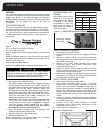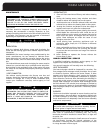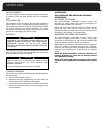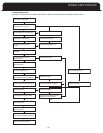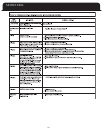
16
WARM AIR FURNACE
THERMOSTAT LOCATION
The thermostat should be located approximately 5 feet above
the floor, on an inside wall where there is good natural air
circulation, and where the thermostat will be exposed to
average room temperatures. Avoid locations where the
thermostat will be exposed to cold drafts, heat from nearby
lamps or appliances, exposure to sunlight, heat from inside
wall stacks, etc.
THERMOSTAT HEAT ANTICIPATOR SETTING:
0.45 AMP (White-Rodgers)
See page 21 for information on connecting optional
accessories such as electronic air cleaners and power
humidifiers.
DANGER
T
HE FURNACE CABINET MUST HAVE AN UNINTERRUPTED
GROUND.
A GROUND WIRE IS PROVIDED IN THE ELECTRICAL
J
UNCTION BOX.
DO NOT USE GAS PIPING AS A GROUND.
FAILING TO GROUND THE FURNACE PROPERLY CAN
RESULT IN ELECTRIC SHOCK RESULTING IN PERSONAL
INJURY OR DEATH.
WARNING
THIS FURNACE IS EQUIPPED WITH A BLOWER DOOR
SAFETY SWITCH. DO NOT DISABLE THIS SWITCH. FAILURE
TO FOLLOW THIS WARNING CAN RESULT IN ELECTRICAL
SHOCK, PERSONAL INJUR
Y
, OR LOSS OF LIFE.
In the United States, all electrical work must be in accordance
with the latest edition of the National Electrical Code, ANSI /
NFPA 70, in Canada, all electrical work must be in accordance
with the latest edition of CSA-C22.1, Canadian Electrical Code
Part 1, and any applicable local code.
Although a suitably located circuit breaker may serve as a
service switch, a separate service switch is recommended.
A separate in service switch is necessary if the circuit breaker
is in a location where accessing it would require getting close
to the furnace, or if the furnace is located between the main
electrical panel and the entry to the furnace room. The
furnace switch (service switch) should be clearly labeled and
installed in a location where it is not likely to be mistaken as
being a light switch or similar control.
FURNACE CONNECTION
120V: The furnace is shipped fully wired except for the
connections to the house wiring. The furnace power
connections are made in a junction box inside the blower
compartment. The junction box is factory installed on the left
hand side however, it may be moved to the right hand side.
The junction box contains a BLACK wire to be connected with
L1 (hot), a WHITE wire to be connected with L2, the Neutral,
and a GREEN wire to be connected to the ground.
Use good quality wire nuts; e.g. Marrette® connectors, Ideal®
wire nuts, etc.
IMPORTANT: USE COPPER CONDUCTORS ONLY
If the junction box must be moved to the right hand side:
1. Unfasten the junction box from the left hand side.
2. Remove the right side panel knockout.
3. Remove the junction box cover hook screw and reinstall it
on the opposite side of the box.
4. Fasten the junction box to the right hand panel.
NOTE: L1 (hot) and L2 (Neutral) polarity must be observed
when making field connections to the furnace. The ignition
control may not sense flame if L1 and L2 are reversed. The
ground is also essential.
NOTE: The furnace shall be installed so the electrical
components are protected from water.
L
OW VOLTAGE WIRING
The low voltage terminals are located on the control board
m
ounted to the blower assembly; see Figure 11 on page 19.
The furnace is prewired for air conditioning. Insert the
thermostat and air conditioner contactor low voltage wiring
through the bushing provided in the side panel. Route the
c
ontrol wiring through the blower compartment to the
24 volt terminal screws.
THERMOSTAT
The room thermostat must be compatible with the integrated
control in the furnace. Electromechanical thermostats should
be rated 30 V / 1.5 amps.
Most electronic or microprocessor based thermostats except
those with "current robbing" circuits should work
satisfactorily. Consult the instructions of the thermostat
manufacturer for technical and installation details.
Most compatibility problems can be overcome by the use of
an isolation relay. The isolation relay should be SPST with a 24-
volt coil. The switch ratings should be a minimum of 0.5 amps;
see figure 9 below.
The thermostat and control wiring should be a minimum of 18
AWG copper. Excessive lengths of wire may result in enough
voltage drop to impair the proper functioning of the furnace.
For thermostat wires in excess of 25 feet, use 16 AWG; 50 feet,
use 14 AWG.
Figure 13: Isolation Relay
THERMOSTAT
COOLING
CONTACTOR
FAN
RELAY
HEATING RELAY
24V
115V
R
G
Y
W
Y
G
W
Figure 9: Isolation relay
CAUTION
ELECTRICAL WIRING AND COMPONENTS MUST BE PROTECTED
FROM MOISTURE, INCLUDING WATER AND CONDENSATE.



